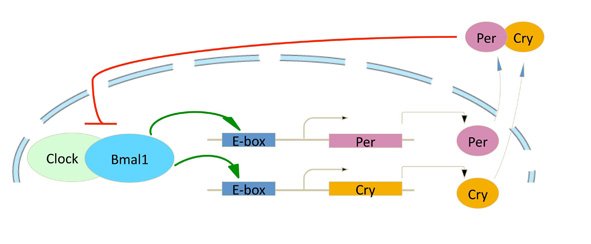User:User:Marcia Ivonne Peña Paz
From Proteopedia
Contents |
BMAL-1
Brain and muscle Arnt (aryl hydrocarbon receptor nuclear translocator) like 1. Also known as MOP3.
Bmal1 is a 69-71KDa transcription factor of the basic helix-loop-helix (bHLH) - PAS family[1]. It is also a major component of both the central and peripheral clocks, and it is part of the transcriptional/translational feedback loop of the circadian timing system.
bHLH = basic- helix-loop-helix; PAS domain = common domain found in Period, Arntl and Sim proteins; PAC = C-terminal motif to PAS domain.
Role
The transcription factor is encoded by the ARNTL / BMAL1 gene in humans and rodents. It maps to human chromosome 11p15.2. Different splicing variants have been reported for Bmal. In mice two isoforms have been found: isoform 1 consist in 626 amino acids and isoform 2 613 amino acids.[1]. It has been reported that it is predominantly expressed at high levels in some areas of the brain, skeletal muscle, cardiac muscle, but it is also expressed in other tissues such as liver or pancreas. [2] [3] [4]
Bmal1 is a core component of the circadian clock, it is also an important element of the circadian pacemaker. Circadian rhythms modulate physiological parameters such as body temperature, blood pressure, feeding behaviour and locomotor activity; therefore, Bmal1 transcription factor plays an important role in the coordination of these functions to the light-dark cycle.
It forms an heterodimer with CLOCK (other bHLH-PAS transcription factors) or its ortholog NPAS2. BMAL1 is acetylated by CLOCK in the residue 537, a highly conserved lysine.[5] The complex formed in the cytoplasm migrates to the nucleus where it binds to E-box promoter of target genes, acting as the positive arm of the feedback loop. They promote the transcription of Cry and Per genes, whose proteins form the negative feedback loop, they heterodimerize and repress CLOCK-BMAL1 complex activity.
CLOCK-BMAL1 complex regulate clock-controlled genes, modulating food intake, hormonal synthesis, body temperature and metabolism. It modulates the expression of the genes RevErbα (nuclear repressor), Dbp (D site albumin promoter)Cry 1/2, Per 1/2/3, Rorα, Pparα, Namt, Ccg, MyoD, CKIε.
Studies
It has been shown that Bmal1 knockout mice have disrupted circadian rhythms, decreased lifespan and reduced activity levels. [6] [7]
Studies in rats and humans suggest that there is a relationship between Bmal1 polymorphisms and hypertension [8]. Disruption of circadian oscillation of glucose metabolism has been related to type 2 diabetis.[9]
As reported by Andrews et al, [10] mice lacking Bmal1 gene have decreased force, shown in whole muscle as in single fibers. This force reduction was interpreted as a result of an altered ultrastructural organization, as the thin- and thick filament spacing in skeletal muscles taken from Bmal1 knockout animals show a greater variability when compared to the precise spacing found in control muscles.
Rescue experiments in the Bmal1 knockout background have shown that re-expression of Bmal1 exclusively in the brain restores circadian rhythm of locomotor activity but not total activity, whereas re-expression of Bmal1 exclusively in skeletal muscle rescues the decrease in total activity levels and lifespan but not the circadian rhythm of locomotor activity [11]
References
- ↑ Ikeda M, Nomura M. cDNA cloning and tissue-specific expression of a novel basic helix-loop-helix/PAS protein (BMAL1) and identification of alternatively spliced variants with alternative translation initiation site usage. Biochem Biophys Res Commun. 1997 Apr 7;233(1):258-64. PMID:9144434 doi:S0006-291X(97)96371-3
- ↑ Namihira M, Honma S, Abe H, Tanahashi Y, Ikeda M, Honma K. Daily variation and light responsiveness of mammalian clock gene, Clock and BMAL1, transcripts in the pineal body and different areas of brain in rats. Neurosci Lett. 1999 May 21;267(1):69-72. PMID:10400251
- ↑ Lamia KA, Storch KF, Weitz CJ. Physiological significance of a peripheral tissue circadian clock. Proc Natl Acad Sci U S A. 2008 Sep 30;105(39):15172-7. Epub 2008 Sep 8. PMID:18779586 doi:10.1073/pnas.0806717105
- ↑ Storch KF, Paz C, Signorovitch J, Raviola E, Pawlyk B, Li T, Weitz CJ. Intrinsic circadian clock of the mammalian retina: importance for retinal processing of visual information. Cell. 2007 Aug 24;130(4):730-41. PMID:17719549 doi:10.1016/j.cell.2007.06.045
- ↑ Hirayama J, Sahar S, Grimaldi B, Tamaru T, Takamatsu K, Nakahata Y, Sassone-Corsi P. CLOCK-mediated acetylation of BMAL1 controls circadian function. Nature. 2007 Dec 13;450(7172):1086-90. PMID:18075593 doi:nature06394
- ↑ Bunger MK, Wilsbacher LD, Moran SM, Clendenin C, Radcliffe LA, Hogenesch JB, Simon MC, Takahashi JS, Bradfield CA. Mop3 is an essential component of the master circadian pacemaker in mammals. Cell. 2000 Dec 22;103(7):1009-17. PMID:11163178
- ↑ Kondratov RV, Kondratova AA, Gorbacheva VY, Vykhovanets OV, Antoch MP. Early aging and age-related pathologies in mice deficient in BMAL1, the core componentof the circadian clock. Genes Dev. 2006 Jul 15;20(14):1868-73. PMID:16847346 doi:10.1101/gad.1432206
- ↑ Woon PY, Kaisaki PJ, Braganca J, Bihoreau MT, Levy JC, Farrall M, Gauguier D. Aryl hydrocarbon receptor nuclear translocator-like (BMAL1) is associated with susceptibility to hypertension and type 2 diabetes. Proc Natl Acad Sci U S A. 2007 Sep 4;104(36):14412-7. Epub 2007 Aug 29. PMID:17728404 doi:10.1073/pnas.0703247104
- ↑ Marcheva B, Ramsey KM, Buhr ED, Kobayashi Y, Su H, Ko CH, Ivanova G, Omura C, Mo S, Vitaterna MH, Lopez JP, Philipson LH, Bradfield CA, Crosby SD, JeBailey L, Wang X, Takahashi JS, Bass J. Disruption of the clock components CLOCK and BMAL1 leads to hypoinsulinaemia and diabetes. Nature. 2010 Jul 29;466(7306):627-31. PMID:20562852 doi:10.1038/nature09253
- ↑ Andrews JL, Zhang X, McCarthy JJ, McDearmon EL, Hornberger TA, Russell B, Campbell KS, Arbogast S, Reid MB, Walker JR, Hogenesch JB, Takahashi JS, Esser KA. CLOCK and BMAL1 regulate MyoD and are necessary for maintenance of skeletal muscle phenotype and function. Proc Natl Acad Sci U S A. 2010 Nov 2;107(44):19090-5. Epub 2010 Oct 18. PMID:20956306 doi:10.1073/pnas.1014523107
- ↑ McDearmon EL, Patel KN, Ko CH, Walisser JA, Schook AC, Chong JL, Wilsbacher LD, Song EJ, Hong HK, Bradfield CA, Takahashi JS. Dissecting the functions of the mammalian clock protein BMAL1 by tissue-specific rescue in mice. Science. 2006 Nov 24;314(5803):1304-8. PMID:17124323 doi:10.1126/science.1132430


